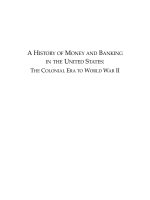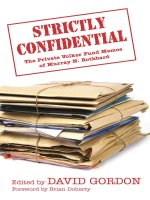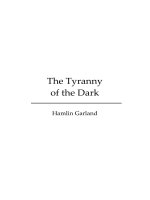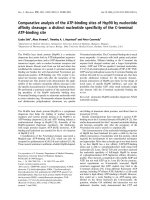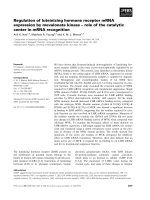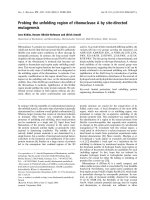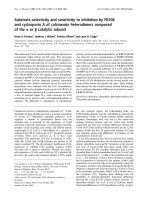BANKING of The Mystery BY MURRAY N. ROTHBARD pot
Bạn đang xem bản rút gọn của tài liệu. Xem và tải ngay bản đầy đủ của tài liệu tại đây (1.66 MB, 322 trang )
BANKING
of
The Mystery
Front Matter.qxp 8/4/2008 11:37 AM Page i
The Ludwig von Mises Institute thanks
Mr. Douglas E. French and Ms. Deanna Forbush
for their magnificent sponsorship
of the publication of this book.
Front Matter.qxp 8/4/2008 11:37 AM Page ii
BANKING
The Mystery
of
Ludwig von Mises Institute
Auburn, Alabama
MURRAY N
. ROTHBARD
SECOND EDITION
Front Matter.qxp 8/4/2008 11:37 AM Page iii
Copyright © 2008 by the Ludwig von Mises Institute
All rights reserved. No part of this book may be reproduced in any
manner whatsoever without written permission except in the case
of reprints in the context of reviews.
For information write the Ludwig von Mises Institute, 518 West
Magnolia Avenue, Auburn, Alabama 36832. Mises.org.
ISBN: 978-1-933550-28-2
Front Matter.qxp 8/4/2008 11:37 AM Page iv
To Thomas Jefferson,
Charles Holt Campbell,
Ludwig von Mises
Champions of Hard Money
Front Matter.qxp 8/4/2008 11:37 AM Page v
Front Matter.qxp 8/4/2008 11:37 AM Page vi
C
ONTENTS
Preface by Douglas E. French . . . . . . . . . . . . . . . . . . . . . . . . xi
Foreword by Joseph T. Salerno . . . . . . . . . . . . . . . . . . . . . . . xv
I. Money: Its Importance and Origins. . . . . . . . . . . . . . . . . . . 1
1. The Importance of Money . . . . . . . . . . . . . . . . . . . . . . . 1
2. How Money Begins . . . . . . . . . . . . . . . . . . . . . . . . . . . . 3
3. The Proper Qualities of Money . . . . . . . . . . . . . . . . . . . 6
4. The Money Unit . . . . . . . . . . . . . . . . . . . . . . . . . . . . . . 8
II. What Determines Prices: Supply and Demand . . . . . . . . 15
III. Money and Overall Prices . . . . . . . . . . . . . . . . . . . . . . . . 29
1. The Supply and Demand for Money and Overall
Prices . . . . . . . . . . . . . . . . . . . . . . . . . . . . . . . . . . . . 29
2. Why Overall Prices Change . . . . . . . . . . . . . . . . . . . . 35
IV. The Supply of Money . . . . . . . . . . . . . . . . . . . . . . . . . . . 43
1. What Should the Supply of Money Be? . . . . . . . . . . . . 44
2. The Supply of Gold and the Counterfeiting Process . . 47
3. Government Paper Money . . . . . . . . . . . . . . . . . . . . . 51
4. The Origins of Government Paper Money . . . . . . . . . 55
vii
Front Matter.qxp 8/4/2008 11:37 AM Page vii
V. The Demand for Money . . . . . . . . . . . . . . . . . . . . . . . . . 59
1. The Supply of Goods and Services . . . . . . . . . . . . . . . 59
2. Frequency of Payment . . . . . . . . . . . . . . . . . . . . . . . . . 60
3. Clearing Systems . . . . . . . . . . . . . . . . . . . . . . . . . . . . . 63
4. Confidence in the Money . . . . . . . . . . . . . . . . . . . . . . 65
5. Inflationary or Deflationary Expectations . . . . . . . . . . 66
VI. Loan Banking . . . . . . . . . . . . . . . . . . . . . . . . . . . . . . . . . 75
VII. Deposit Banking . . . . . . . . . . . . . . . . . . . . . . . . . . . . . . 85
1. Warehouse Receipts . . . . . . . . . . . . . . . . . . . . . . . . . . 85
2. Deposit Banking and Embezzlement . . . . . . . . . . . . . . 90
3. Fractional Reserve Banking . . . . . . . . . . . . . . . . . . . . . 94
4. Bank Notes and Deposits . . . . . . . . . . . . . . . . . . . . . . 104
VIII. Free Banking and the Limits on
Bank Credit Inflation. . . . . . . . . . . . . . . . . . . . . . . . . . . . 111
IX. Central Banking: Removing the Limits . . . . . . . . . . . . . 125
X. Central Banking: Determining Total Reserves . . . . . . . . 141
1. The Demand for Cash . . . . . . . . . . . . . . . . . . . . . . . . 141
2. The Demand for Gold . . . . . . . . . . . . . . . . . . . . . . . . 148
3. Loans to the Banks. . . . . . . . . . . . . . . . . . . . . . . . . . . 149
4. Open Market Operations . . . . . . . . . . . . . . . . . . . . . . 153
XI. Central Banking: The Process of Bank
Credit Expansion . . . . . . . . . . . . . . . . . . . . . . . . . . . . . . . 161
1. Expansion from Bank to Bank . . . . . . . . . . . . . . . . . . 161
2. The Central Bank and the Treasury . . . . . . . . . . . . . . 170
XII. The Origins of Central Banking. . . . . . . . . . . . . . . . . . 177
1. The Bank of England . . . . . . . . . . . . . . . . . . . . . . . . . 177
2. Free Banking in Scotland . . . . . . . . . . . . . . . . . . . . . . 183
3. The Peelite Crackdown, 1844–1845 . . . . . . . . . . . . . 186
viii The Mystery of Banking
Front Matter.qxp 8/4/2008 11:37 AM Page viii
XIII. Central Banking in the United States I: The Origins. . 191
1. The Bank of North America and the First
Bank of the United States. . . . . . . . . . . . . . . . . . . . . 191
2. The Second Bank of the United States . . . . . . . . . . . . 198
XIV. Central Banking in the United States II:
The 1820s to the Civil War . . . . . . . . . . . . . . . . . . . . . . 207
1. The Jacksonian Movement and the Bank War . . . . . . 207
2. Decentralized Banking from the 1830s to the
Civil War . . . . . . . . . . . . . . . . . . . . . . . . . . . . . . . . . 214
XV. Central Banking in the United States III: The National
Banking System . . . . . . . . . . . . . . . . . . . . . . . . . . . . . . . 219
1. The Civil War and the National Banking System . . . . 219
2. The National Banking Era and the Origins
of the Federal Reserve System . . . . . . . . . . . . . . . . . 229
XVI. Central Banking in the United States IV:
The Federal Reserve System . . . . . . . . . . . . . . . . . . . . . . . 235
1. The Inflationary Structure of the Fed . . . . . . . . . . . . 235
2. The Inflationary Policies of the Fed . . . . . . . . . . . . . 241
XVII. Conclusion: The Present Banking
Situation and What to Do About It . . . . . . . . . . . . . . . . 247
1. The Road to the Present . . . . . . . . . . . . . . . . . . . . . . 247
2. The Present Money Supply . . . . . . . . . . . . . . . . . . . . 252
3. How to Return to Sound Money . . . . . . . . . . . . . . . 261
Appendix: The Myth of Free Banking in Scotland . . . . . . . 269
Index . . . . . . . . . . . . . . . . . . . . . . . . . . . . . . . . . . . . . . . . . 293
Contents ix
Front Matter.qxp 8/4/2008 11:37 AM Page ix
Front Matter.qxp 8/4/2008 11:37 AM Page x
PREFACE
A
lthough first published 25 years ago, Murray Rothbard’s
The Mystery of Banking continues to be the only book that
clearly and concisely explains the modern fractional
reserve banking system, its origins, and its devastating effects on
the lives of every man, woman, and child. It is especially appro-
priate in a year that will see; a surge in bank failures, central
banks around the globe bailing out failed commercial and invest-
ment banks, double-digit inflation rates in many parts of the
world and hyperinflation completely destroying Zimbabwe’s
economy, that a new edition of Rothbard’s classic work be repub-
lished and made available through the efforts of Lew Rockwell
and the staff at the Ludwig von Mises Institute at an obtainable
price for students and laymen interested in the vagaries of bank-
ing and how inflation and business cycles are created.
In the absence of central-bank intervention, the current finan-
cial meltdown could be a healthy check on the inflation of the
banking system as Rothbard points out in his scathing review of
Lawrence H. White’s Free Banking in Britain: Theory, Experience,
and Debate, 1800–1845 that first appeared in The Review of Aus-
trian Economics and is included as a part of this new edition to
correct Rothbard’s initial support of White’s work in the first edi-
tion. There have been virtually no bank failures in the United
xi
Front Matter.qxp 8/4/2008 11:37 AM Page xi
States since the early 1990s and as Rothbard surmised during that
period where there was “an absence of failure” that “inflation of
money and credit [was] all the more rampant.” Indeed, from Jan-
uary 1990 to April 2008, the United States M-2 money supply
more than doubled from $3.2 trillion to $7.7 trillion. Bankers
were living it up, “at the expense of society and the economy far-
ing worse” (Rothbard’s emphasis).
Although ostensibly it is dodgy real estate loans that are bring-
ing the banks down this year, in the seminal book that you hold,
Rothbard shows that it is really the fraudulent nature of fraction-
alized banking that is the real culprit for the bankers’ demise.
But central bankers will never learn. “We should not have a
system that’s this fragile, that causes this much risk to the econ-
omy,” New York Federal Reserve President Tim Geithner said
after engineering J.P. Morgan’s bailout of the failed Bear Stearns
investment bank in the first quarter of 2008 with the help of the
central bank. Of course the thought of dismantling his employer,
the government leaving the counterfeiting business, and a return
to using the market’s money—gold—didn’t occur to him. More
government regulation in which “the basic rules of the game
establish stronger incentives for building more robust shock
absorbers,” is what he prescribed.
Surely Murray is somewhere laughing.
My introduction to The Mystery of Banking came in 1992 as
I was finishing my thesis at UNLV under Murray’s direction. I
found the book in the university library and couldn’t put it down.
The book was long out of print by that time and being prior to
the start of Amazon.com and other online used book searches, I
was unable to find a copy of the book for purchase. Thus, I fed
dimes into the library copier one Saturday afternoon and made
myself a copy. When the online searches became available I
waited patiently and bought two copies when they surfaced, pay-
ing many times the original $19.95 retail price (as I write this
AbeBooks.com has three copies for sale ranging from $199 to
$225, and Bauman Rare Books recently sold a signed first edition
for $650).
xii The Mystery of Banking
Front Matter.qxp 8/4/2008 11:37 AM Page xii
When I discovered Rothbard’s great work I had been a banker
for six years, but like most people working in banking, I had no
clear understanding of the industry. It is not knowledge that is
taught on the job. Murray may have referred to me as “the effi-
cient banker,” but he was the one who knew the evil implications
of the modern fractionalized banking system: “the pernicious and
inflationary domination of the State.”
D
OUGLAS E. F
RENCH
LAS VEGAS, NEVADA
JUNE 2008
Preface xiii
Front Matter.qxp 8/4/2008 11:37 AM Page xiii
Front Matter.qxp 8/4/2008 11:37 AM Page xiv
FOREWORD
L
ong out of print, The Mystery of Banking is perhaps the
least appreciated work among Murray Rothbard’s prodi-
gious body of output. This is a shame because it is a model
of how to apply sound economic theory, dispassionately and
objectively, to the origins and development of real-world institu-
tions and to assess their consequences. It is “institutional econom-
ics” at its best. In this book, the institution under scrutiny is cen-
tral banking as historically embodied in the Federal Reserve
System—the “Fed” for short—the central bank of the United
States.
The Fed has long been taken for granted in American life and,
since the mid-1980s until very recently, had even come to be ven-
erated. Economists, financial experts, corporate CEOs, Wall
Street bankers, media pundits, and even the small business own-
ers and investors on Main Street began to speak or write about
the Fed in awed and reverential terms. Fed Chairmen Paul Vol-
cker and especially his successor Alan Greenspan achieved mythic
stature during this period and were the subjects of a blizzard of
fawning media stories and biographies. With the bursting of the
high-tech bubble in the late 1990s, the image of the Fed as the deft
and all-seeing helmsman of the economy began to tarnish. But it
was the completely unforeseen eruption of the wave of sub-prime
xv
Foreword v6.qxp 8/4/2008 11:37 AM Page xv
mortgage defaults in the middle of this decade, followed by the
Fed’s panicky bailout of major financial institutions and the onset
of incipient stagflation, that has profoundly shaken the wide-
spread confidence in the wisdom and competence of the Fed.
Never was the time more propitious for the radical and penetrat-
ing critique of the Fed and fractional-reserve banking that Roth-
bard offers in this volume.
Before taking a closer look at the book’s contents and contri-
butions, a brief account of its ill-fated publication history is in
order. It was originally published in 1983 by a short-lived and
eclectic publishing house, Richardson & Snyder, which also pub-
lished around the same time God’s Broker, the controversial book
on the life of Pope John Paul II by Antoni Gronowicz. The latter
book was soon withdrawn, which led to the dissolution of the
company. A little later, the successor company, Richardson &
Steirman, published the highly touted A Time for Peace by Mikhail
Gorbachev, then premier of the U.S.S.R. This publishing coup,
however, did not prevent this firm from also winding up its affairs
in short order, as it seems to have disappeared after 1988.
In addition to its untimely status as an orphan book, there
were a number of other factors that stunted the circulation of The
Mystery of Banking. First, several reviewers of the original edition
pointedly noted the lax, or nonexistent, copy editing and inferior
production standards that disfigured its appearance. Second, in an
important sense, the book was published “before its time.” In
1983, its year of publication, the efforts of the Volcker Fed to rein
in the double-digit price inflation of the late 1970s had just begun
to show success. Price inflation was to remain at or below 5 per-
cent for the rest of the decade. During the 1990s, inflation, as
measured by the Consumer Price Index, declined even further
and hovered between 2 and 3 percent. This led the Greenspan
Fed and most professional monetary economists to triumphantly
declare victory over the inflation foe and even to raise the possi-
bility of a return of the deflation bogey.
Despite the adverse circumstances surrounding its publica-
tion, however, The Mystery of Banking has gone on to become a
xvi The Mystery of Banking
Foreword v6.qxp 8/4/2008 11:37 AM Page xvi
true underground classic. At the time of this writing, four used
copies are for sale on Amazon.com for between $124.50 and
$256.47. These prices are many times higher than the pennies
asked for standard money-and-banking textbooks published in
the 1980s and even exceed the wildly inflated prices of the latest
editions of these textbooks that are extracted from captive audi-
ences of college students. Such price discrepancies are a good
indication that Rothbard’s book is very different—in content,
style, and organization—from standard treatments of the subject.
Rothbard’s book is targeted at a readership actively interested
in learning about the subject and not at indifferent students
slouching in the 500-seat amphitheatres of our “research” univer-
sities. While it is therefore written in Rothbard’s characteristically
sparkling prose it does not shy away from a rigorous presentation
of the basic theoretical principles that govern the operation of the
monetary system. Indeed the book is peppered with diagrams,
charts, and tables aplenty—and even a simple equation or two.
But before you run for the hills, you should know that it is not a
“textbook” in the conventional sense.
Conventional money-and-banking textbooks confront the
hapless reader with a jumble of dumbed-down mainstream theo-
ries and models. Some of these have been discredited and most
bear very little systematic relationship to one another or are in
actual conflict. The Quantity Theory, in both its “classical” and
monetarist versions, Keynes’s liquidity preference theory of inter-
est, the New Keynesian Aggregate Supply curve, the expectations-
augmented Phillips curve–one after another, all make their dreary
appearance on the scene. Worse yet, this theoretical hodgepodge
is generally set out in the last four or five chapters of the textbook
and is usually preceded by a bland recitation of random technical
details and historical facts about monetary and financial institu-
tions. Unfortunately, the befuddled reader cannot make heads or
tails out of these facts without the guidance of a coherent theory.
For the privilege of being bewildered, misled, and eventually
bored to tears by this indigestible intellectual stew, students get to
pay $100 or more for the textbook.
Foreword xvii
Foreword v6.qxp 8/4/2008 11:37 AM Page xvii
Rothbard will have none of this shabby and disrespectful
treatment of his reader and of his science that is meted out by the
typical textbook author. In sharp contrast, he begins by first
clearly presenting the fundamental principles or “laws” that gov-
ern money and monetary institutions. These universal and
immutable laws form a fully integrated system of sound monetary
theory that has been painstakingly elaborated over the course of
centuries by scores of writers and economists extending back at
least to the sixteenth-century Spanish Scholastics of the School of
Salamanca. As the leading authority in this tradition in the latter
half of the twentieth century, Rothbard expounds its core princi-
ples in a logical, step-by-step manner, using plain and lucid prose
and avoiding extraneous details. He supplements his verbal-logi-
cal analysis with graphs and charts to effectively illustrate the
operation of these principles in various institutional contexts.
It is noteworthy that, despite the fact that this book was writ-
ten twenty-five years ago, the theory Rothbard presents is up to
date. One reason is that the advancement of knowledge in non-
experimental or “aprioristic” sciences like economic theory, logic,
and mathematics proceeds steadily but slowly. In the case of
sound monetary theory, many of its fundamental principles had
been firmly established during the nineteenth century. In the Ger-
man edition of The Theory of Money and Credit published in
1912, Ludwig von Mises, Rothbard’s mentor, integrated these
principles with value and price theory to formulate the modern
theory of money and prices. Rothbard elaborated upon and
advanced Mises’s theoretical system. Thus the second reason that
the monetary theory presented in the book remains fresh and rel-
evant is that Rothbard himself was the leading monetary econo-
mist in the sound money tradition in the second half of the twen-
tieth century, contributing many of the building blocks to the
theoretical structure that he lays out. These include: formulating
the proper criteria for calculating the money supply in a fractional-
reserve banking system; identifying the various components of the
demand for money; refining and consistently applying the supply-
and-demand apparatus to analyzing the value of money; drawing
xviii The Mystery of Banking
Foreword v6.qxp 8/4/2008 11:37 AM Page xviii
a categorical distinction between deposit banking and loan bank-
ing; providing the first logical and coherent explanation of how
fiat money came into being and displaced commodity money as a
result of a series of political interventions. All these innovations
and more were products of Rothbard’s creative genius, and many
of his theoretical breakthroughs have not yet been adequately rec-
ognized by contemporary monetary theorists, even of the Aus-
trian School.
Rothbard’s presentation of the basic principles of money-and-
banking theory in the first eleven chapters of the book guides the
reader in unraveling the mystery of how the central bank operates
to create money through the fractional-reserve banking system
and how this leads to inflation of the money supply and a rise in
overall prices in the economy. But he does not stop there. In the
subsequent five chapters he resolves the historical mystery of how
an inherently inflationary institution like central banking, which
is destructive of the value of money and, in the extreme case of
hyperinflation, of money itself, came into being and was accepted
as essential to the operation of the market economy.
As in the case of his exposition of the theory, Rothbard’s
treatment of the history of the Fed is fundamentally at odds with
that found in standard textbooks. In the latter, the history is shal-
low and episodic. It is taken for granted that the Fed, like all cen-
tral banks, was originally designed as an institution whose goal
was to promote the public interest by operating as a “lender of
last resort,” providing “liquidity” to troubled banks during times
of financial turbulence to prevent a collapse of the financial sys-
tem. Later the Fed was given a second mandate, to maintain “sta-
bility of the price level,” a policy which was supposed to rid the
economy of business cycles and therefore to preclude prolonged
periods of recession and unemployment. Thus strewn throughout
a typical textbook one will find accounts of how the Fed han-
dled—usually, although not always, in an enlightened manner—
various “shocks” to the monetary and financial system. Culpabil-
ity for such shocks is almost invariably attributed to the unruly
propensities or irrational expectations of business investors,
Foreword xix
Foreword v6.qxp 8/4/2008 11:37 AM Page xix
consumers, or wage-earners. Even in the exceptional instances,
such as the Great Depression, when inept Fed policy is blamed for
making matters worse, the Fed’s errors are ascribed to not yet
having learned how to properly wield the “tools of monetary pol-
icy,” the euphemism used to describe the various techniques the
Fed uses in exercising its legal monopoly of counterfeiting money.
Each new crisis, however, stimulates the public-spirited policy-
makers at the Fed by a trial-and-error process to eventually con-
verge on the optimal monetary policy, which was supposedly hit
upon in the heyday of the Greenspan Fed during 1990s.
Rothbard rejects such a superficial and naïve account of the
Fed’s origins and bolstering of the banking system development.
Instead, he deftly uses sound monetary theory to beam a penetrat-
ing light through the thick fog of carefully cultivated myths that
surround the operation of the Fed. Rather than recounting the
Fed’s response to isolated crises, he blends economic theory with
historical insight to reveal the pecuniary and ideological motives
of the specific individuals who played key roles in establishing,
molding, and operating the Fed. Needless to say, Rothbard does
not blithely accept the almost universal view that the Fed is the
outcome of a public-spirited response to shocks and failures
caused by unruly market forces. Rather he asks, and then answers,
the incisive, and always disturbing, question, “Cui bono?” (“To
whose benefit?”). In other words, which particular individuals
and groups stood to benefit from the Fed’s creation and its spe-
cific policies? In answering this question, Rothbard fearlessly
names names and delves into the covert motives and goals of
those named.
This constitutes yet another, and possibly the most important,
reason why Rothbard’s book had been ignored: for it is forbidden
to even pose the question of “who benefits” with respect to the
Fed and its legal monopoly of the money supply, lest one be
smeared and marginalized as a “conspiracy theorist.” Strangely,
when a similar question is asked regarding the imposition of tar-
iffs or government regulations of one sort or another, no one
seems to bat an eye, and free-market economists even delight in
xx The Mystery of Banking
Foreword v6.qxp 8/4/2008 11:37 AM Page xx
and win plaudits for uncovering such “rent-seekers” in their pop-
ular and academic publications. Thus economists of the Chicago
and Public Choice Schools have explained the origins and policies
of Federal regulatory agencies such as the ICC, CAB, FDA, FTC,
FCC, etc., as powerfully shaped by the interests of the industries
that they regulated. Yet these same economists squirm in discom-
fort and seek a quick escape when confronted with the question
of why this analysis does not apply to the Fed. Indeed, Rothbard
does no more than portray the Fed as a cartelizing device that lim-
its entry into and regulates competition within the lucrative frac-
tional-reserve banking industry and stands ready to bail it out,
thus guaranteeing its profits and socializing its losses. Rothbard
further demonstrates, that not only bankers, but also incumbent
politicians and their favored constituencies and special interest
groups benefit from the Fed’s power to create money at will. This
power is routinely used in the service of vote-seeking politicians
to surreptitiously tax money holders to promote the interests of
groups that gain from artificially cheap interest rates and direct
government subsidies. These beneficiaries include, among others,
Wall Street financial institutions, manufacturing firms that pro-
duce capital goods, the military-industrial complex, the construc-
tion and auto industries, and labor unions.
With the U.S. housing crisis metamorphosing into a full-
blown financial crisis in the U.S. and Europe and the specter of a
global stagflation looming larger every day, the Fed’s credibility
and reputation is evaporating with the value of the U.S. dollar.
The time is finally ripe to publish this new edition of the book
that asked the forbidden question about the Fed and fractional-
reserve banking when it was first published twenty-five years ago.
J
OSEPH T. SALERNO
PACE UNIVERSITY
J
ULY 2008
Foreword xxi
Foreword v6.qxp 8/4/2008 11:37 AM Page xxi
Foreword v6.qxp 8/4/2008 11:37 AM Page xxii
I.
MONEY: ITS IMPORTANCE
AND
ORIGINS
1. T
HE IMPORTANCE OF
MONEY
T
oday, money supply figures pervade the financial press.
Every Friday, investors breathlessly watch for the latest
money figures, and Wall Street often reacts at the opening
on the following Monday. If the money supply has gone up
sharply, interest rates may or may not move upward. The press is
filled with ominous forecasts of Federal Reserve actions, or of
regulations of banks and other financial institutions.
This close attention to the money supply is rather new. Until
the 1970s, over the many decades of the Keynesian Era, talk of
money and bank credit had dropped out of the financial pages.
Rather, they emphasized the GNP and government’s fiscal policy,
expenditures, revenues, and deficits. Banks and the money supply
were generally ignored. Yet after decades of chronic and acceler-
ating inflation—which the Keynesians could not begin to cure—
and after many bouts of “inflationary recession,” it became obvious
1
Chapter One.qxp 8/4/2008 11:37 AM Page 1
to all—even to Keynesians—that something was awry. The money
supply therefore became a major object of concern.
But the average person may be confused by so many defini-
tions of the money supply. What are all the Ms about, from M1-
A and M1-B up to M-8? Which is the true money supply figure,
if any single one can be? And perhaps most important of all, why
are bank deposits included in all the various Ms as a crucial and
dominant part of the money supply? Everyone knows that paper
dollars, issued nowadays exclusively by the Federal Reserve Banks
and imprinted with the words “this note is legal tender for all
debts, public and private” constitute money. But why are check-
ing accounts money, and where do they come from? Don’t they
have to be redeemed in cash on demand? So why are checking
deposits considered money, and not just the paper dollars backing
them?
One confusing implication of including checking deposits as a
part of the money supply is that banks create money, that they are,
in a sense, money-creating factories. But don’t banks simply chan-
nel the savings we lend to them and relend them to productive
investors or to borrowing consumers? Yet, if banks take our sav-
ings and lend them out, how can they create money? How can
their liabilities become part of the money supply?
There is no reason for the layman to feel frustrated if he can’t
find coherence in all this. The best classical economists fought
among themselves throughout the nineteenth century over
whether or in what sense private bank notes (now illegal) or
deposits should or should not be part of the money supply. Most
economists, in fact, landed on what we now see to be the wrong
side of the question. Economists in Britain, the great center of
economic thought during the nineteenth century, were particu-
larly at sea on this issue. The eminent David Ricardo and his suc-
cessors in the Currency School, lost a great chance to establish
truly hard money in England because they never grasped the fact
that bank deposits are part of the supply of money. Oddly
enough, it was in the United States, then considered a backwater
of economic theory, that economists first insisted that bank
2 The Mystery of Banking
Chapter One.qxp 8/4/2008 11:37 AM Page 2
